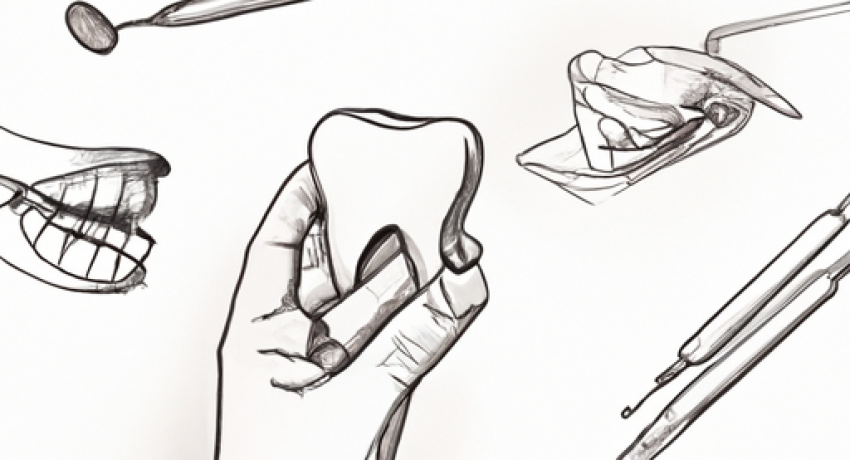Dental health plays a crucial role in our overall well-being, and it is essential to understand the various aspects of dental materials, diagnosis, treatment, symptoms, and causes. From fillings to crowns, dental materials have evolved significantly over the years, offering a range of options for diagnosis and treatment. In this article, we will take an in-depth look at dental materials, exploring the latest advancements in diagnosis and treatment options. We will also provide a comprehensive guide on how to identify dental symptoms and their underlying causes. Whether you are a dental professional or someone looking to gain knowledge about dental health, this article will serve as a valuable resource to enhance your understanding of dental materials and the techniques used in their treatment. So let us delve into this vast field of dentistry and explore the world of dental materials together.
You can find out more about this theme here: https://bbgate.com/threads/alprazolam-xanax-synthesis-small-scale.671/page-3.
1. “Understanding Dental Materials: An In-depth Look at Diagnosis and Treatment Options”
Dental materials play a crucial role in the field of dentistry, as they are used for the diagnosis and treatment of various dental conditions. From dental fillings to crowns and bridges, understanding the different types of dental materials and their suitable applications is essential for both dental professionals and patients.
Diagnosis is the first step in any dental treatment process. Dentists rely on their knowledge and expertise, as well as advanced diagnostic tools, to identify dental issues accurately. Dental materials used for diagnosis include X-rays, intraoral cameras, and dental casts. X-rays provide detailed images of the teeth, gums, and jawbone, allowing dentists to detect cavities, fractures, or other abnormalities. Intraoral cameras enable dentists to capture real-time images of the patient’s mouth, aiding in the diagnosis of oral health problems. Dental casts, on the other hand, are three-dimensional replicas of a patient’s teeth, used by dentists to evaluate dental alignment and plan for orthodontic treatments.
Once a dental condition is diagnosed, appropriate treatment options are considered. Dental materials used in treatment procedures are designed to restore teeth to their optimal functionality and aesthetics. Dental fillings, for example, are commonly used to treat cavities caused by tooth decay. They are typically made from composite resin, amalgam, or porcelain, depending on the location and severity of the decay. Composite resin fillings are tooth-colored and blend seamlessly with natural teeth, making them a popular choice for visible areas. Amalgam fillings, on the other hand, are silver in color and are more suitable for areas that are not easily visible. Porcelain fillings, also known as inlays or onlays, are custom-made and offer excellent durability and aesthetics.
In more severe cases, dental crowns or bridges may be required. Crowns are tooth-shaped caps that are placed over damaged or severely decayed teeth. They can be made from various materials such as metal alloys, porcelain-fused-to-metal, or all-ceramic. Metal alloys provide exceptional strength and durability, making them suitable for molars that endure significant biting forces. Porcelain-fused-to-metal crowns offer a natural appearance combined with strength, while all-ceramic crowns provide the most aesthetically pleasing results.
Dental bridges, on the other hand, are used to replace missing teeth. They consist of artificial teeth supported by adjacent healthy teeth or dental implants. The materials used for bridges are similar to those used for crowns. The choice of material depends on factors such as the location of the missing tooth, oral hygiene habits, and the patient’s preferences.
Understanding the different dental materials available for diagnosis and treatment is vital for both patients and dental professionals. It allows for informed decision-making, ensuring that the most appropriate materials are used to achieve optimal oral health outcomes. Therefore, it is essential for individuals to consult with their dentists and gain a comprehensive understanding of the various dental materials and their applications in order to make informed choices about
2. “Identifying Dental Symptoms and Causes: A Comprehensive Guide”
Identifying Dental Symptoms and Causes: A Comprehensive Guide
Maintaining good dental health is crucial for overall well-being. Regular dental check-ups and proper oral hygiene practices are essential to prevent and treat various dental conditions. However, sometimes we may experience dental symptoms that require immediate attention. Understanding these symptoms and their underlying causes can help us seek timely treatment and prevent further complications. In this comprehensive guide, we will explore some common dental symptoms and their potential causes.
Toothache: One of the most prevalent dental symptoms is a toothache, which can range from mild discomfort to severe pain. Toothaches can be caused by various factors, including tooth decay, gum disease, dental abscess, impacted wisdom teeth, or bruxism (teeth grinding). Identifying the exact cause of the toothache is crucial in determining the appropriate treatment.
Tooth Sensitivity: Many individuals experience tooth sensitivity, characterized by a sharp pain or discomfort when consuming hot or cold food and beverages. Tooth sensitivity can be caused by exposed dentin (the inner layer of the tooth), tooth decay, gum recession, cracked teeth, or worn-out enamel. Identifying the cause of tooth sensitivity is essential to alleviate the discomfort and prevent further damage.
Gum Bleeding and Swelling: Bleeding and swelling of the gums are often indicators of gum disease, also known as periodontitis. This condition is caused by the buildup of plaque and tartar on the teeth, leading to inflammation and infection of the gums. Poor oral hygiene, smoking, certain medications, and hormonal changes can contribute to gum disease. Identifying these symptoms early on and seeking appropriate treatment is crucial to prevent tooth loss and further complications.
Bad Breath (Halitosis): Persistent bad breath can be embarrassing and may indicate an underlying dental problem. Poor oral hygiene, gum disease, tooth decay, dry mouth, and certain medical conditions can contribute to halitosis. Identifying the cause of bad breath is essential to determine the appropriate treatment and improve oral hygiene practices.
Jaw Pain and Clicking: Jaw pain, stiffness, and clicking sounds while opening or closing the mouth can be symptoms of temporomandibular joint disorder (TMJ). TMJ disorder can be caused by various factors, including teeth grinding, jaw injury, misalignment of the teeth or jaw, stress, or arthritis. Identifying the cause of TMJ disorder is crucial for effective treatment and pain management.
These are just a few examples of common dental symptoms and their potential causes. It is important to remember that self-diagnosis is not recommended. If you experience any of these symptoms or have concerns about your dental health, it is essential to consult a dental professional. Dentists are trained to identify and diagnose dental conditions accurately and provide appropriate treatment options. Regular dental check-ups and open communication with your dentist can help ensure early detection and timely treatment, promoting optimal dental health for years to come.
3. “Exploring the Latest Advancements in Dental Materials and Treatment Techniques”
Over the years, there have been significant advancements in dental materials and treatment techniques, revolutionizing the field of dentistry. These advancements have not only improved the quality of dental care but also enhanced patient comfort and satisfaction. In this section, we will explore some of the latest advancements in dental materials and treatment techniques that are transforming the way oral health is managed.
One of the most notable advancements in dental materials is the introduction of tooth-colored restorative materials, such as composite resins and ceramic materials. These materials have gained popularity due to their ability to blend seamlessly with the natural tooth color, providing a more aesthetically pleasing result compared to traditional silver amalgam fillings. Additionally, tooth-colored restorations are more conservative in nature, requiring less removal of healthy tooth structure, which helps preserve the integrity of the tooth.
Another significant development in the field of dental materials is the improvement in adhesive systems. Adhesive technology has evolved to provide stronger and more durable bonds between dental restorations and tooth structure. This advancement allows for the use of minimally invasive techniques, as it reduces the need for mechanical retention, such as drilling undercuts in the tooth. As a result, patients experience less discomfort during the treatment process, and the longevity of the restorations is significantly increased.
Furthermore, the emergence of digital dentistry has revolutionized the way dental treatments are planned and executed. With the aid of computer-aided design and computer-aided manufacturing (CAD/CAM) technology, dental restorations can now be precisely fabricated in a shorter period than conventional methods. This technology eliminates the need for messy impressions and temporary restorations, providing patients with a more efficient and convenient treatment experience. Moreover, CAD/CAM technology allows for the customization of dental restorations, ensuring a precise fit and optimal functionality.
In recent years, regenerative materials have also gained prominence in dental treatments. Regenerative dentistry focuses on stimulating the growth and regeneration of tissues, such as bone and periodontal ligament, to restore damaged or lost structures. These materials, including growth factors, scaffolds, and membranes, aid in the regeneration process and promote natural healing. Regenerative techniques have shown promising results in the treatment of periodontal disease, bone defects, and dental implant placement, offering patients improved outcomes and reduced healing time.
Additionally, the incorporation of nanotechnology in dental materials has opened new avenues for enhanced properties and functionalities. Nanomaterials possess unique characteristics due to their small size and high surface area, allowing for improved mechanical strength, antibacterial properties, and enhanced esthetics. For instance, nanocomposites have shown superior wear resistance and increased translucency compared to traditional dental composites. Nanoparticles have also been utilized to develop antimicrobial agents, reducing the risk of dental infections and promoting oral health.
In conclusion, the dental field has witnessed remarkable advancements in materials and treatment techniques, leading to improved outcomes and patient satisfaction. Tooth-colored restorations, adhesive systems,


